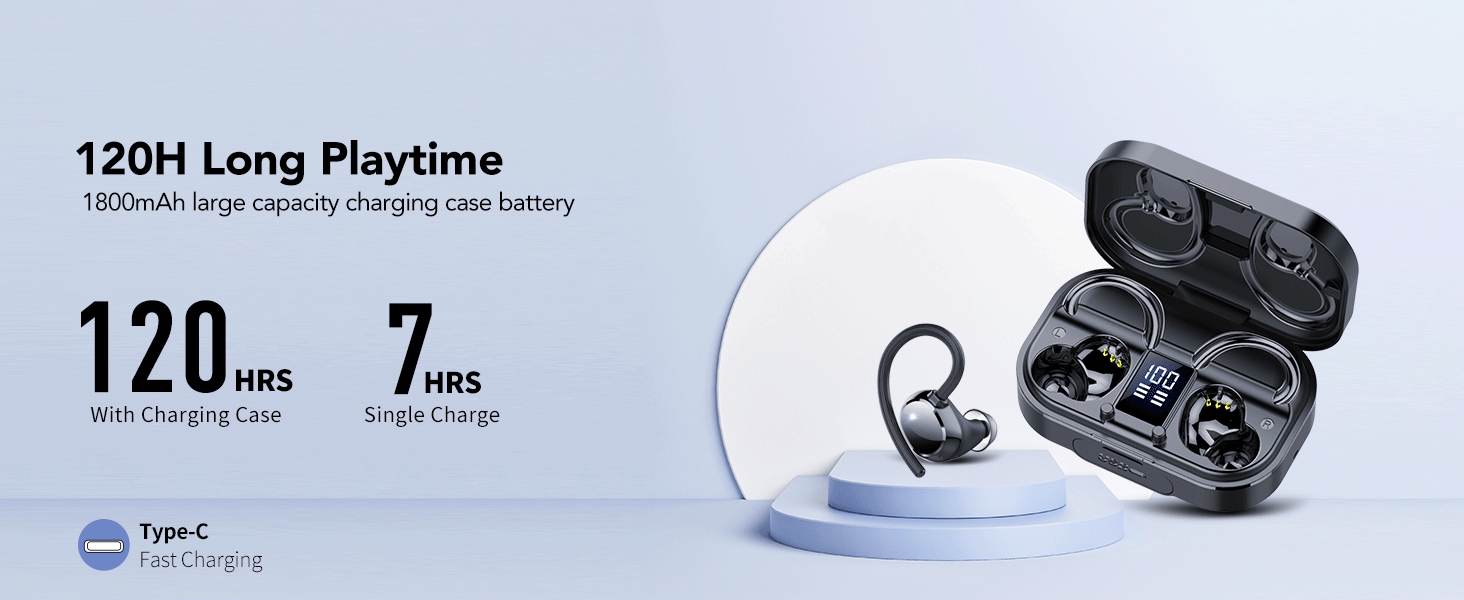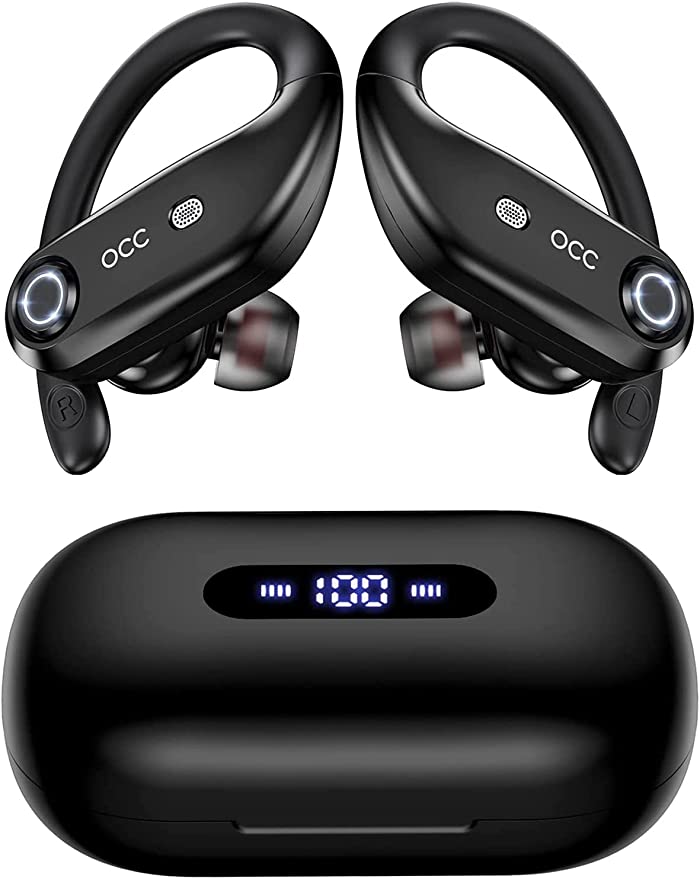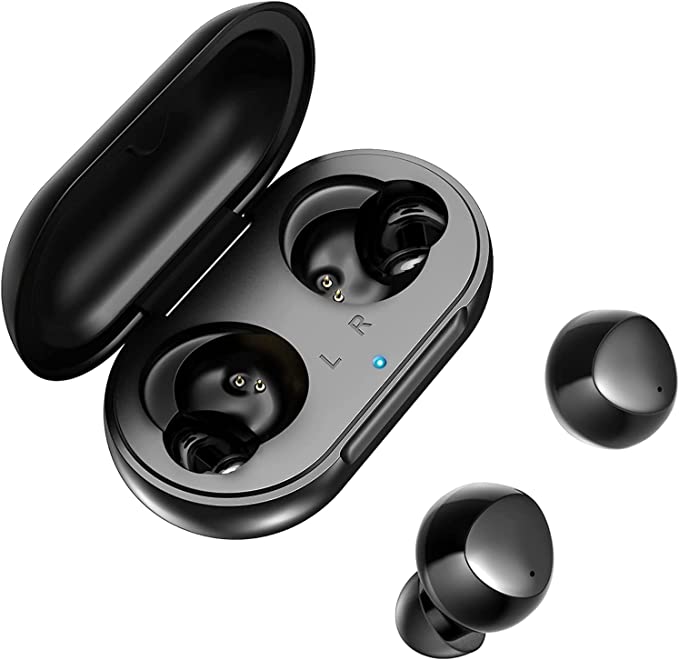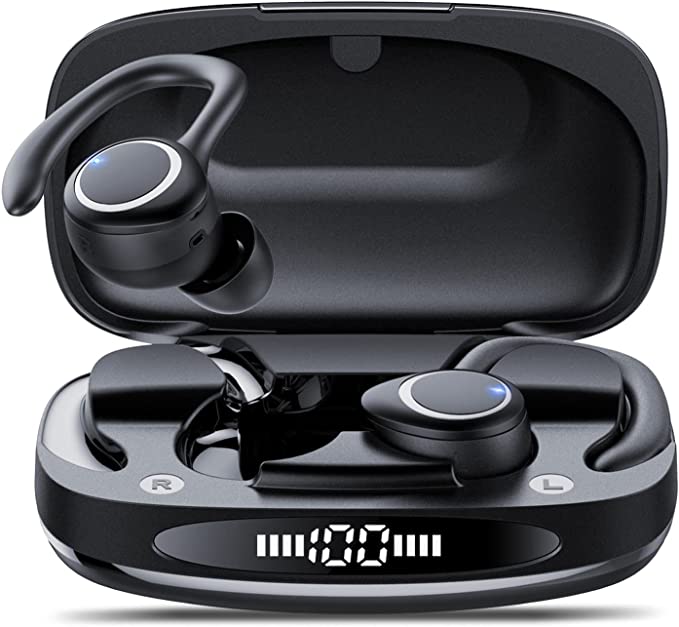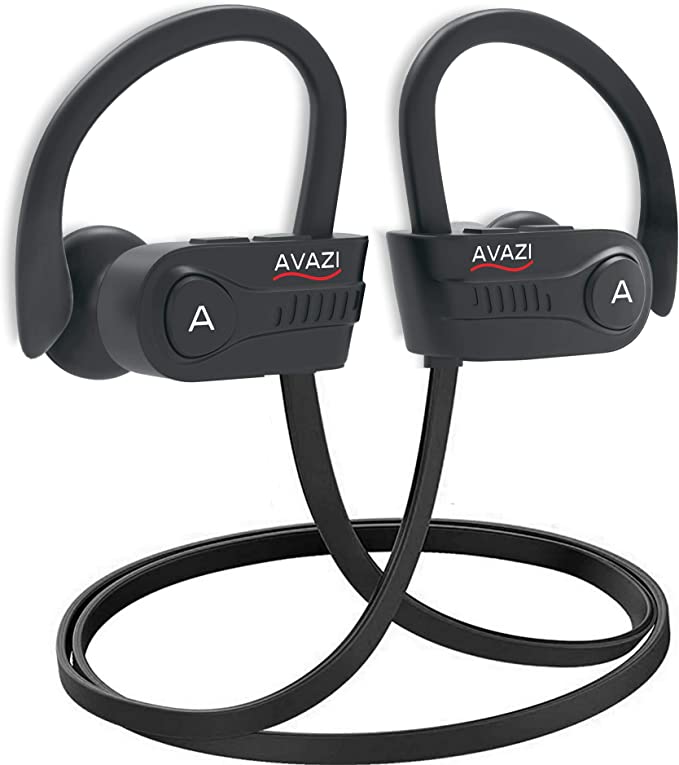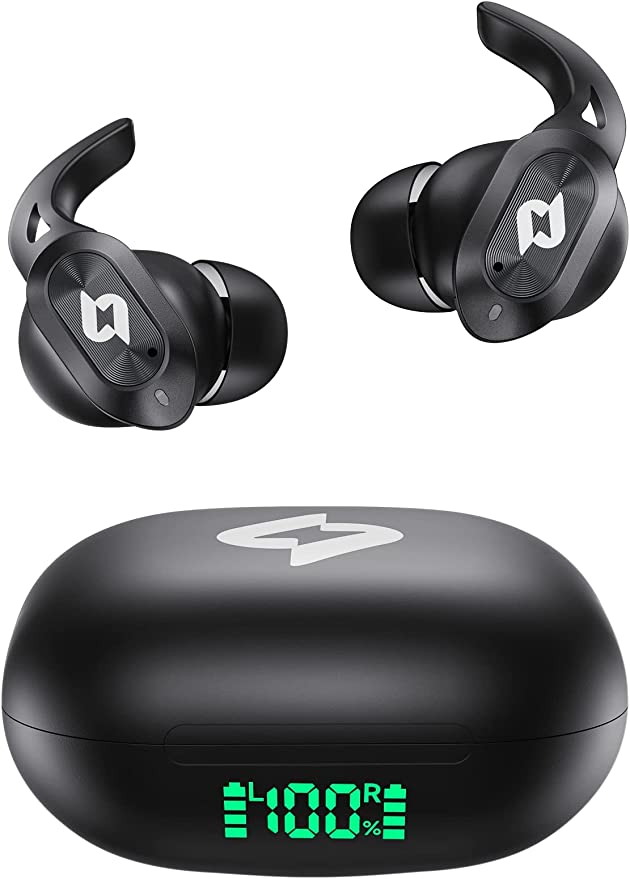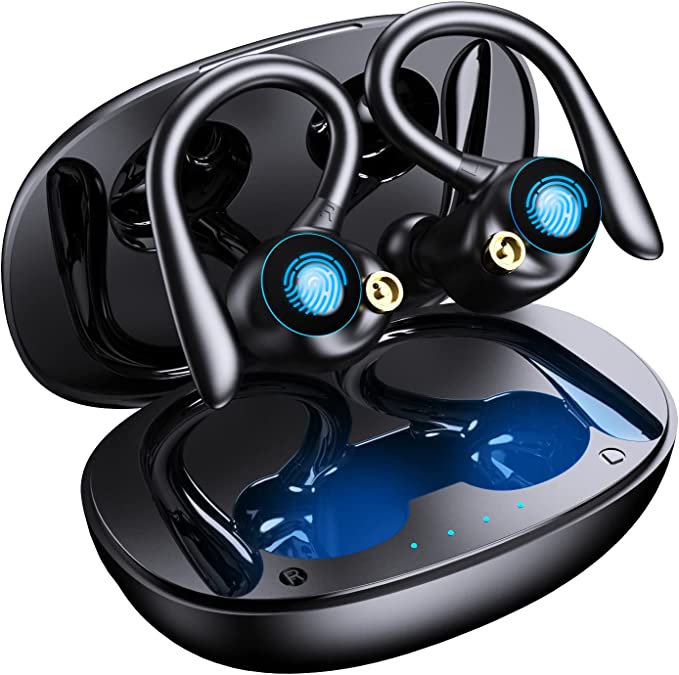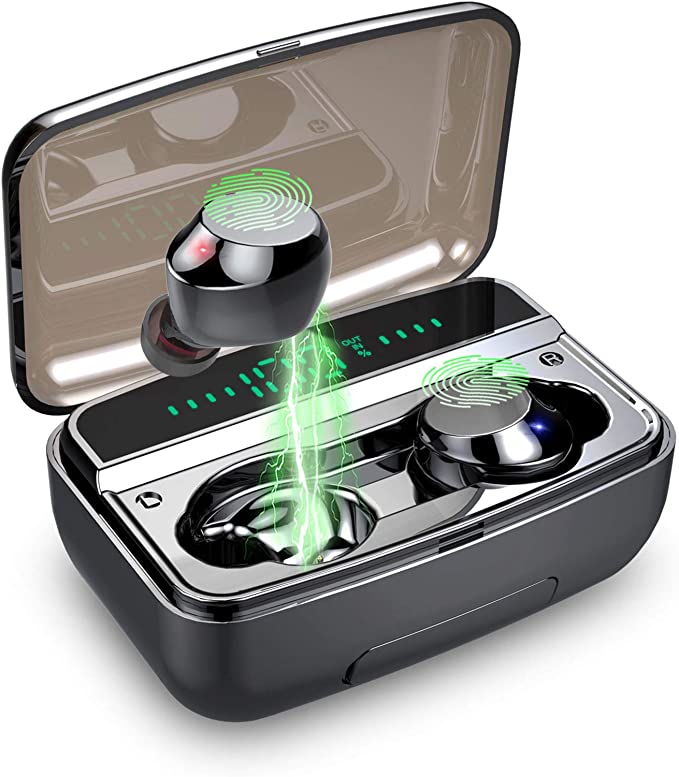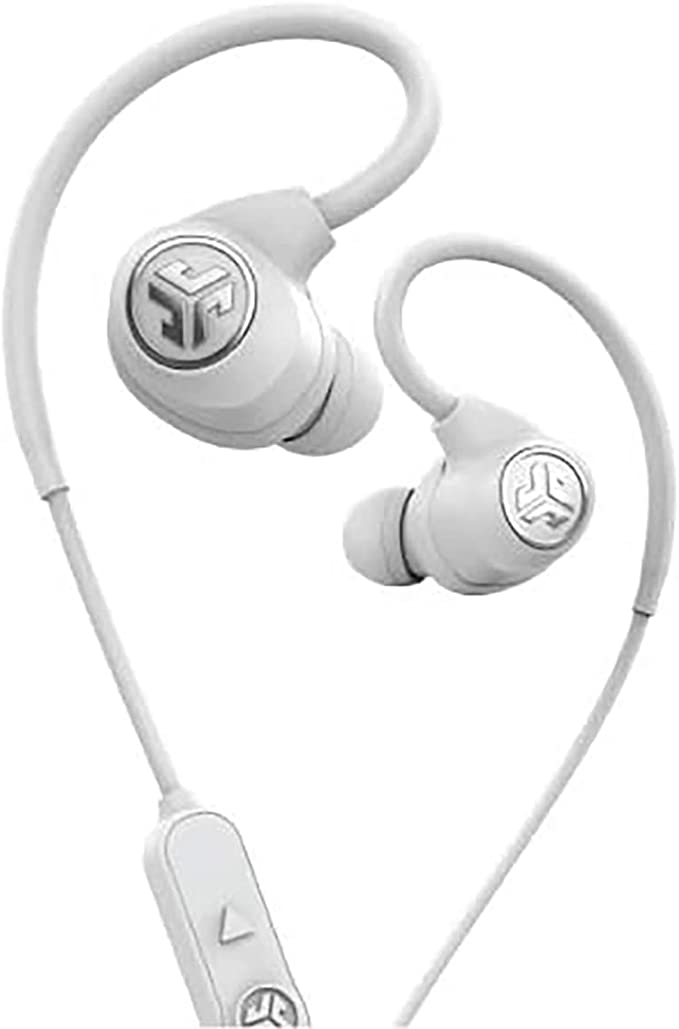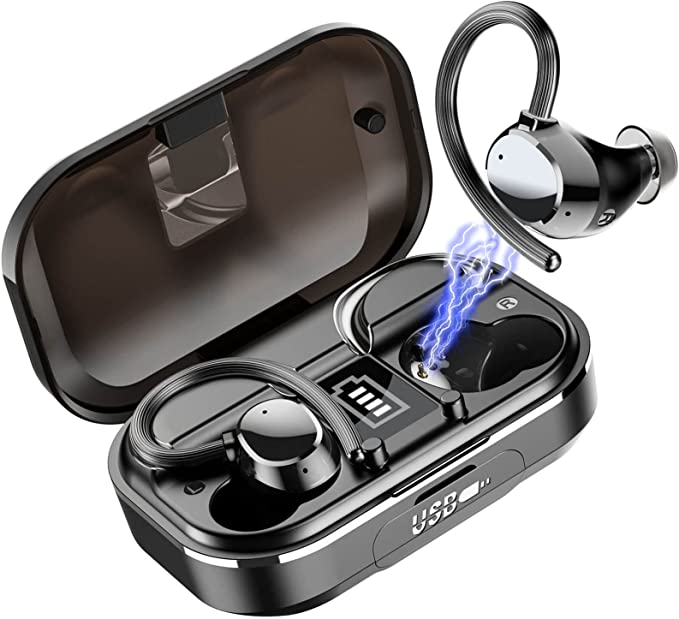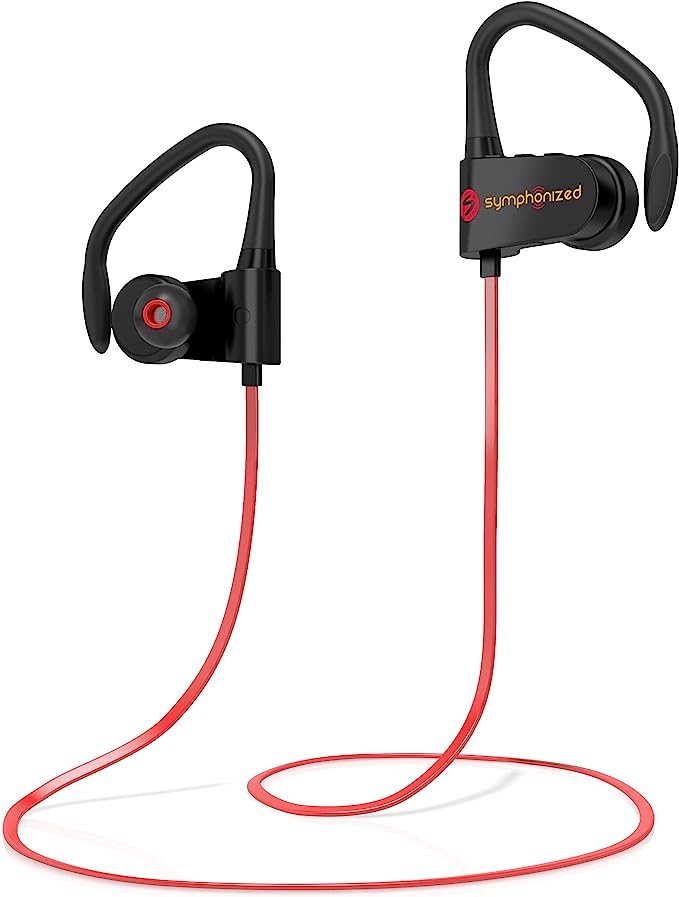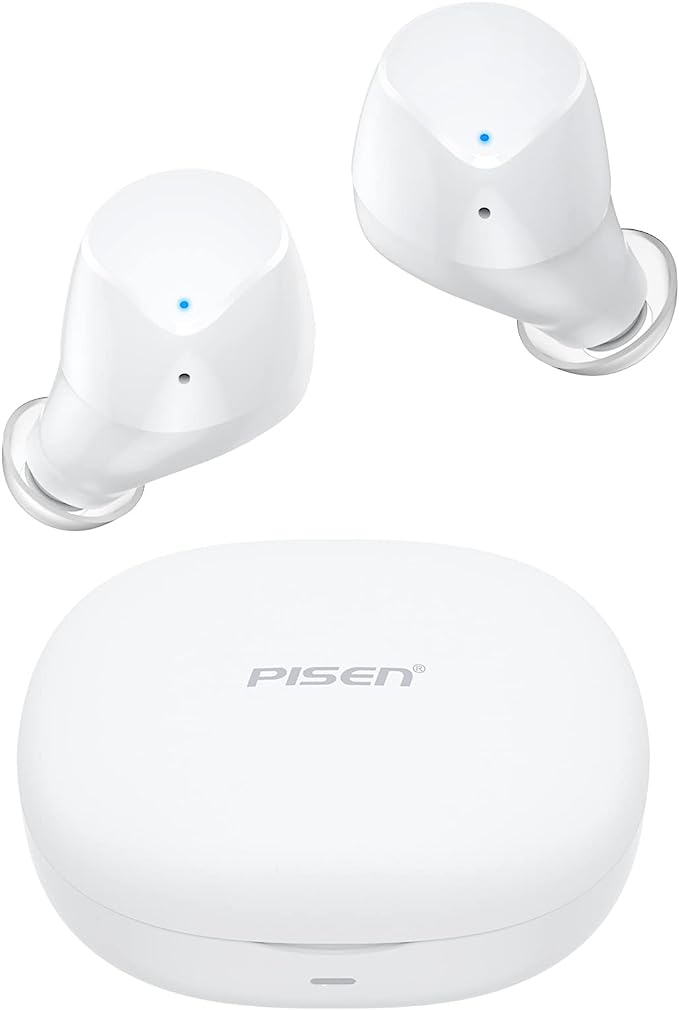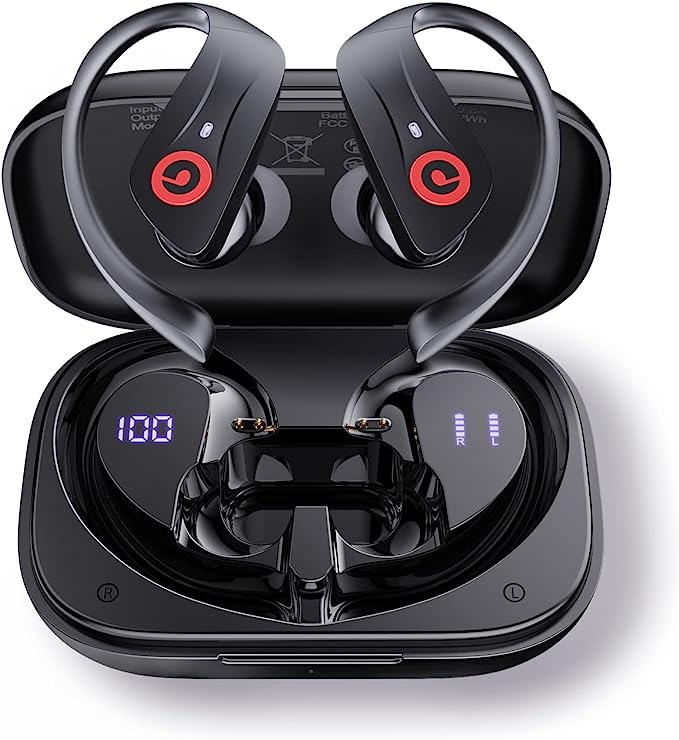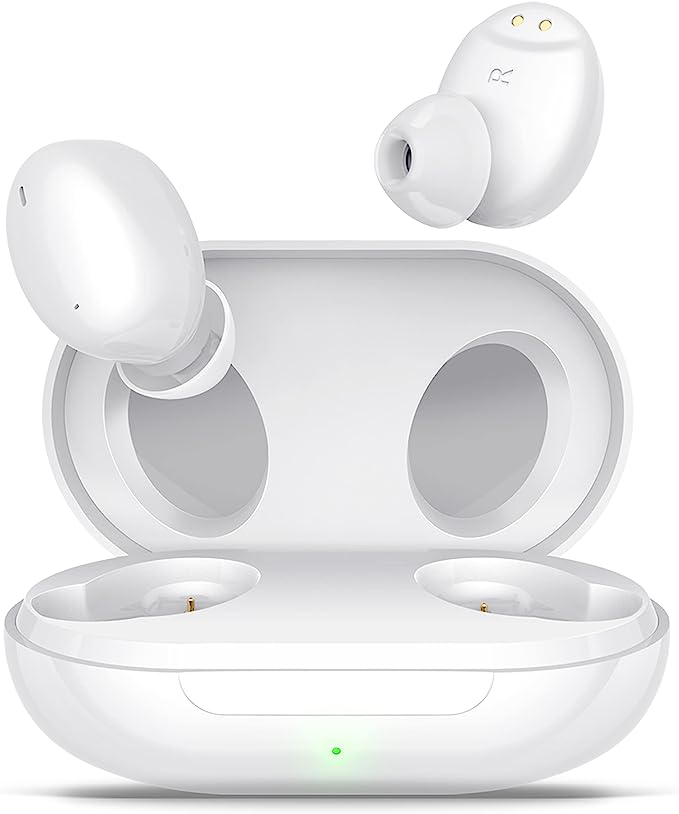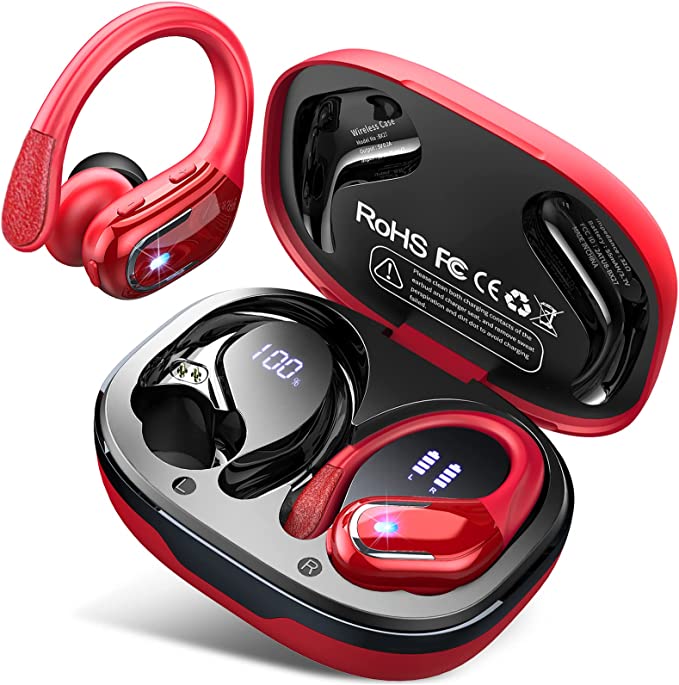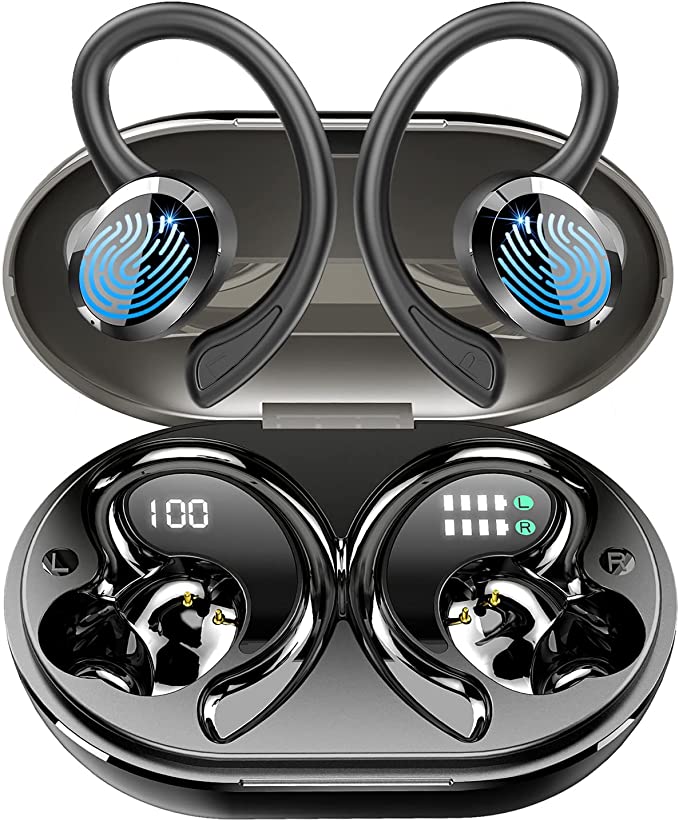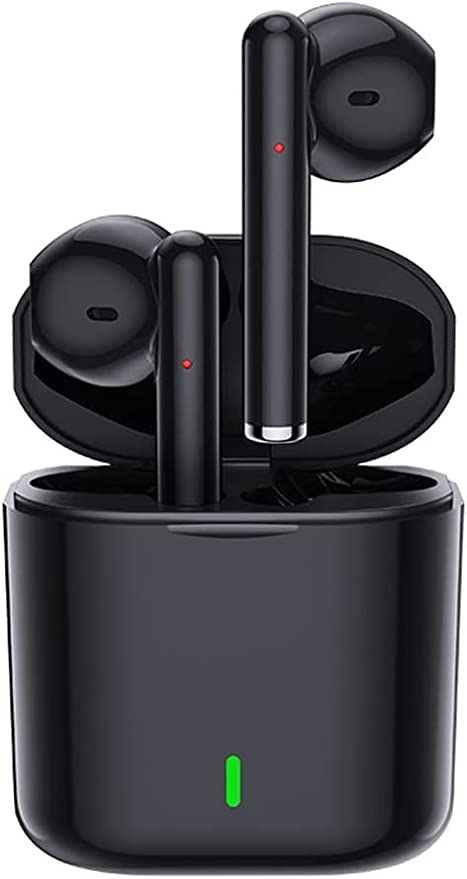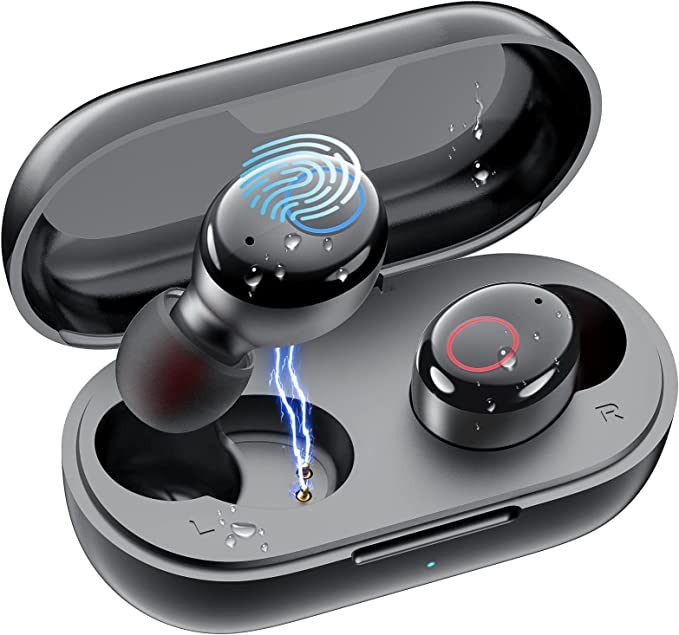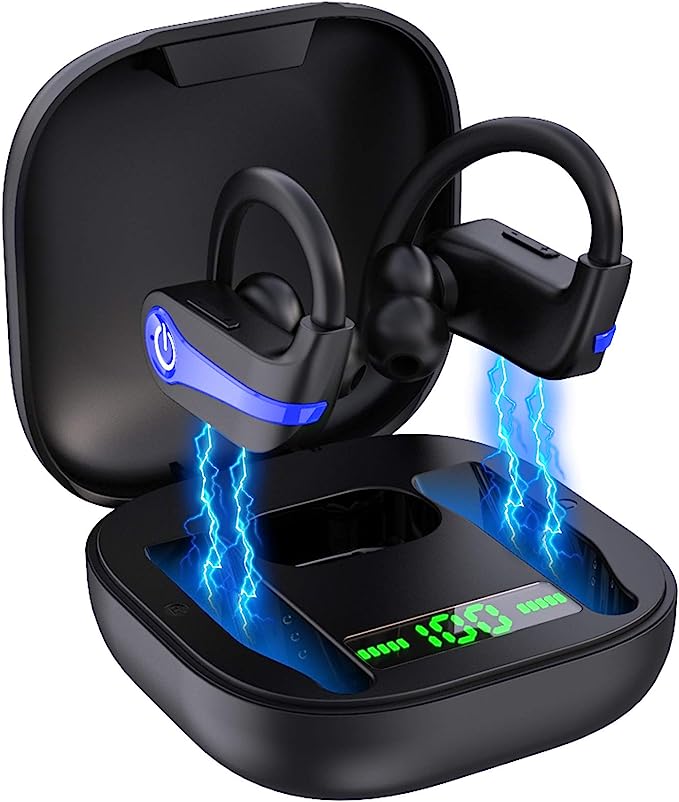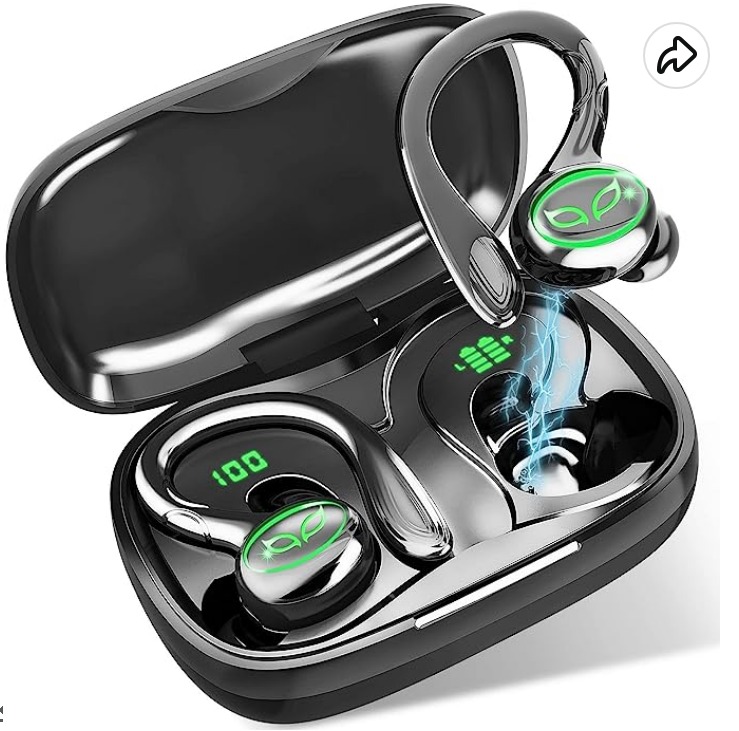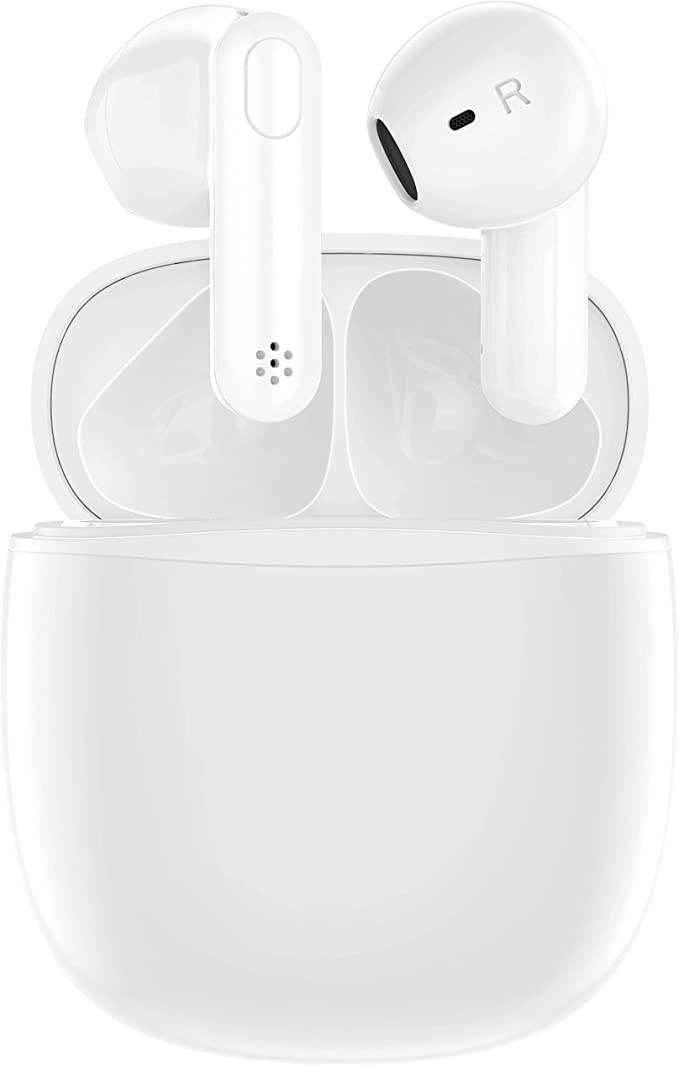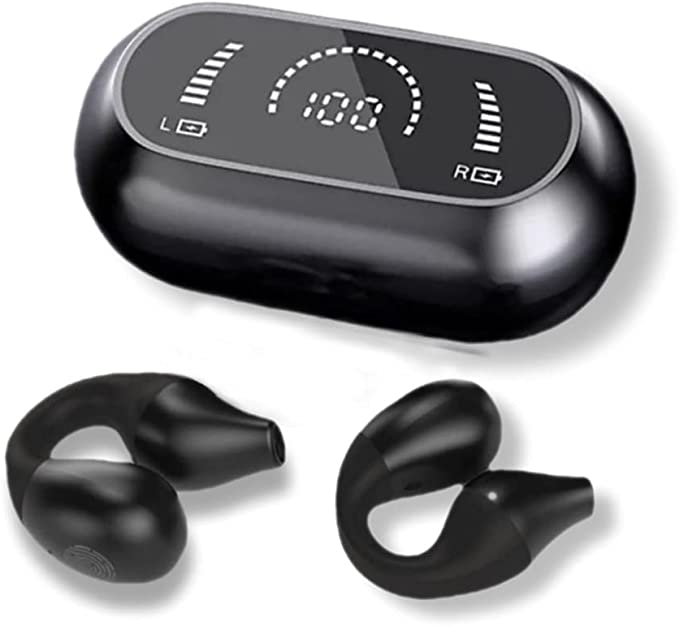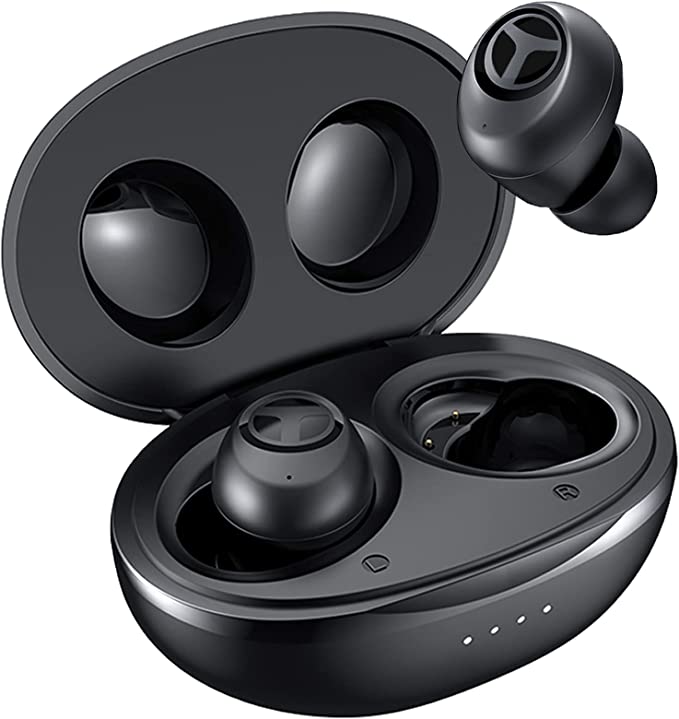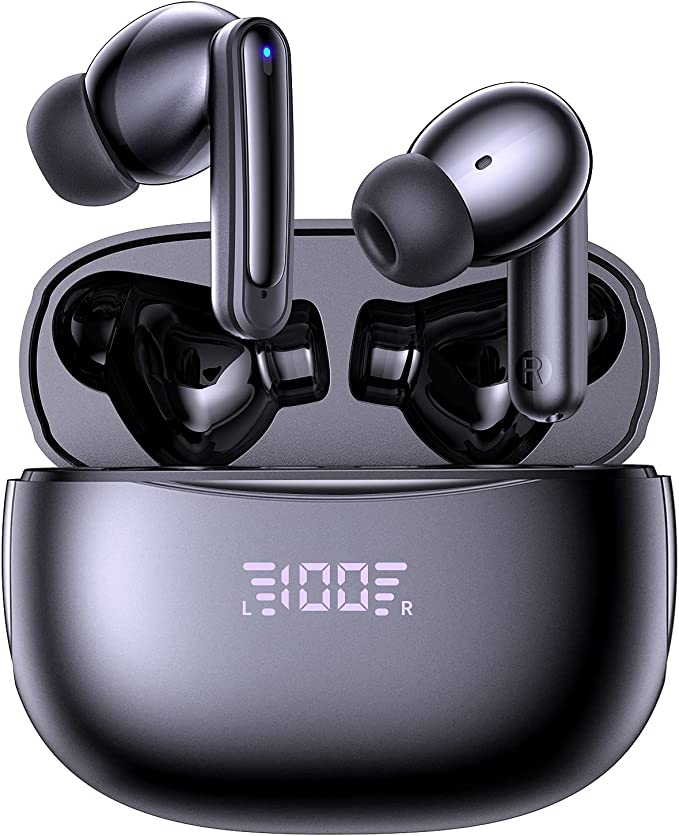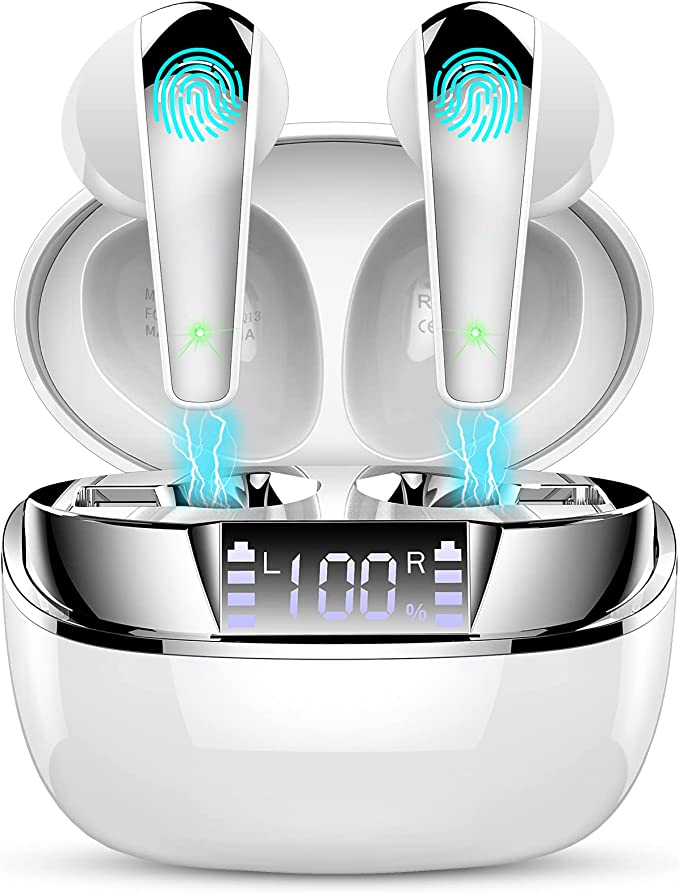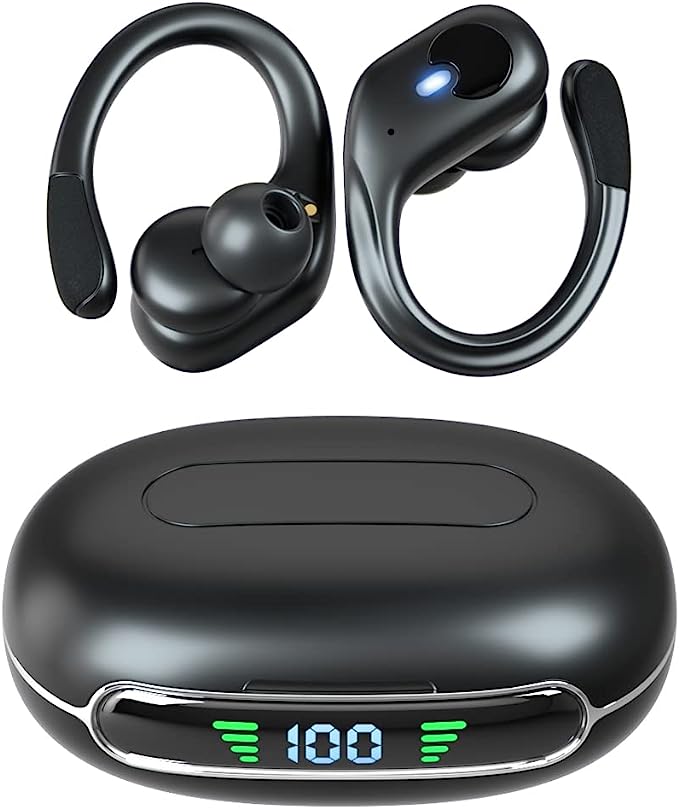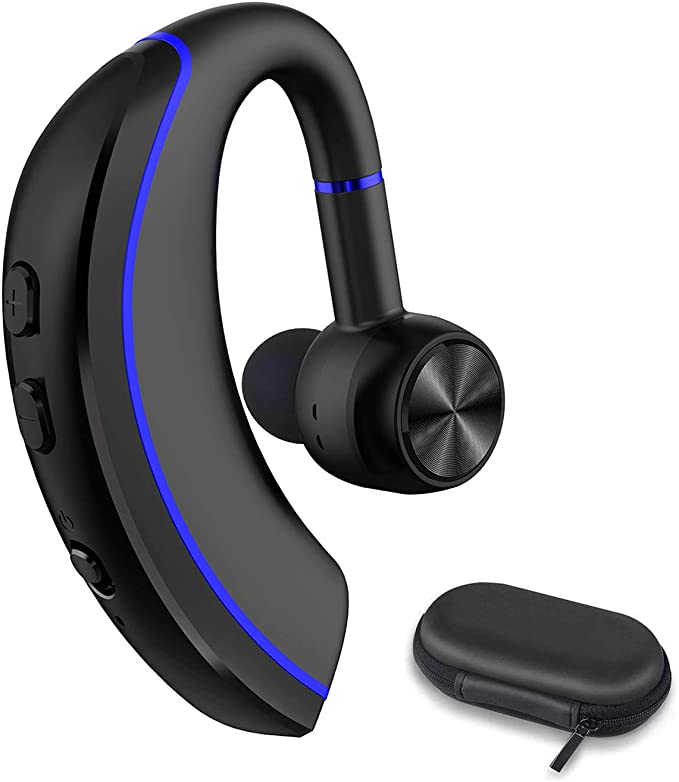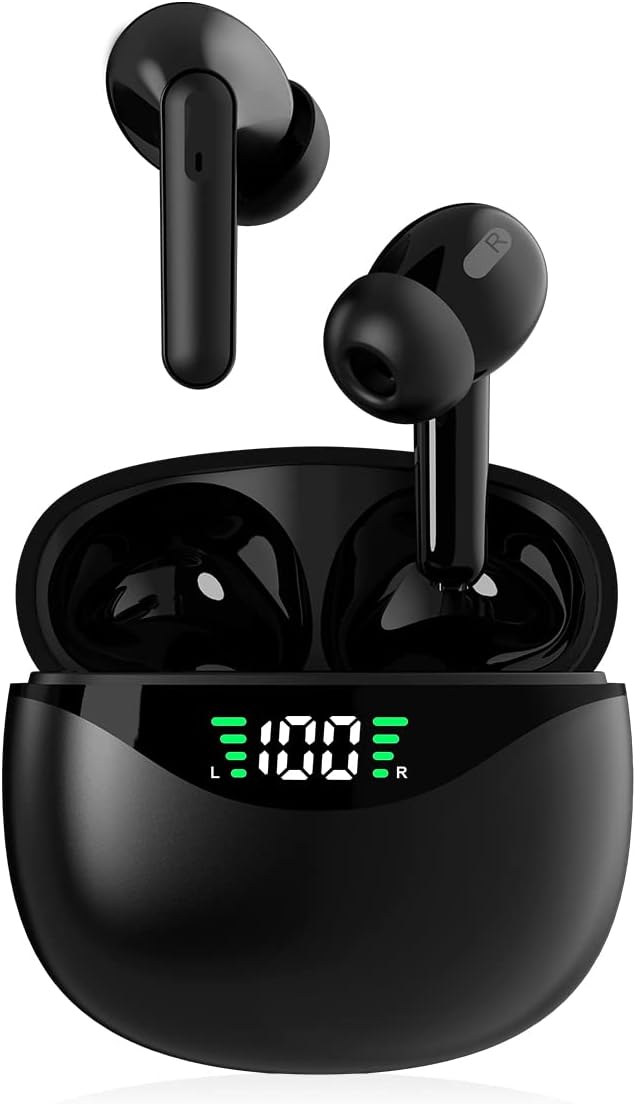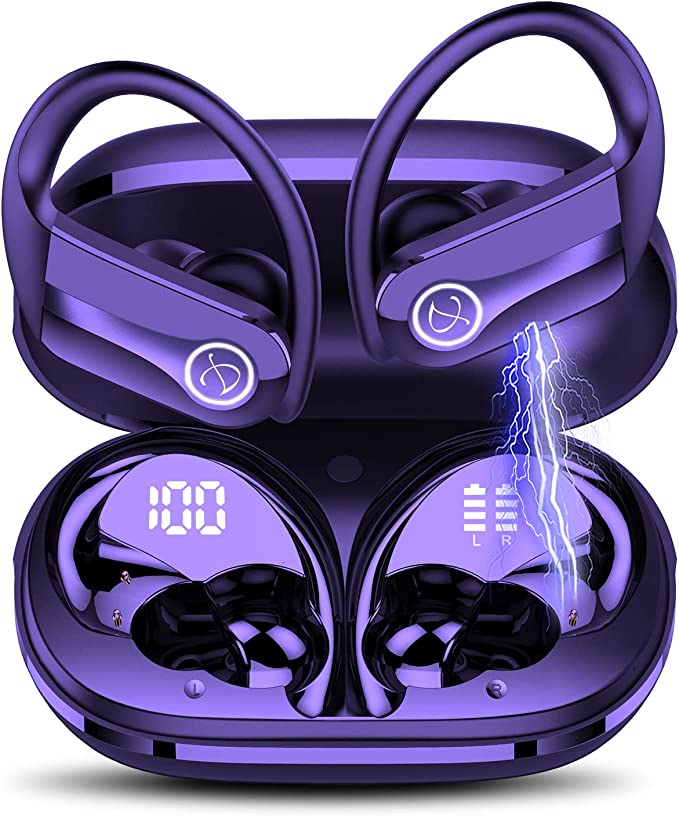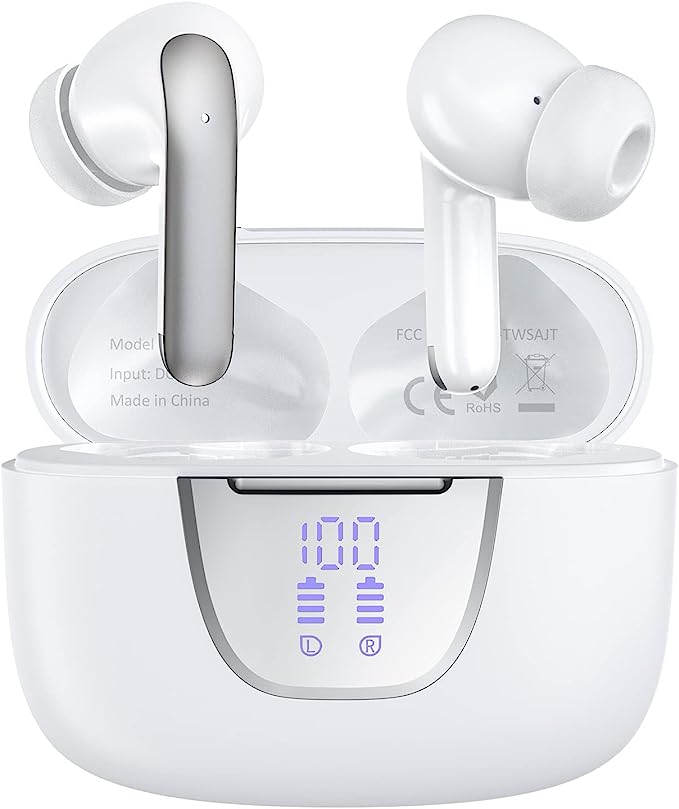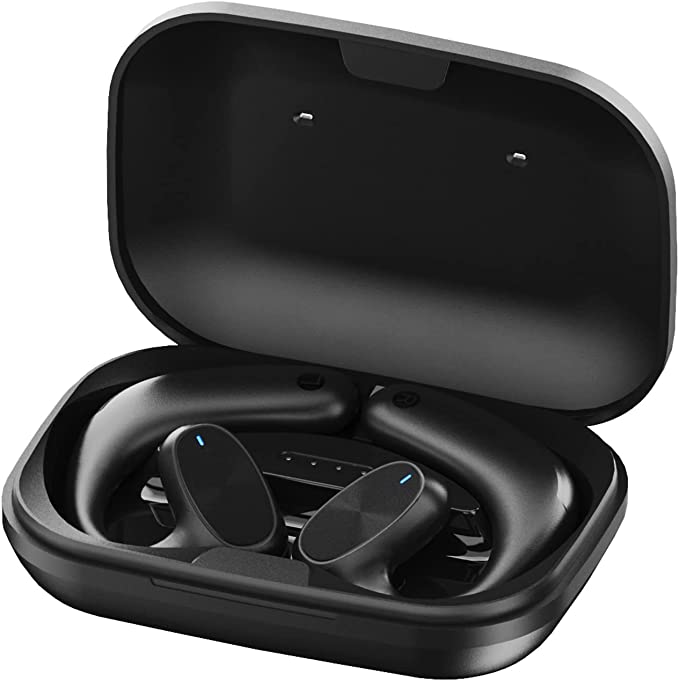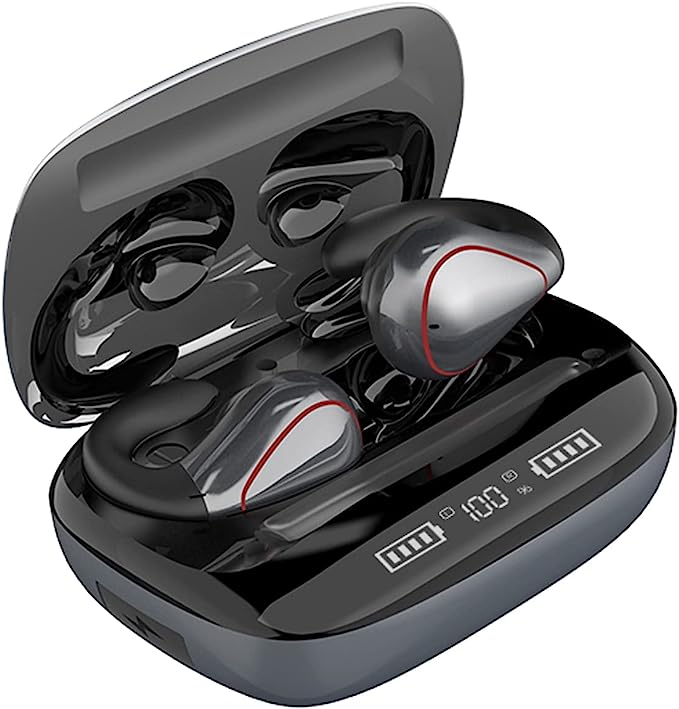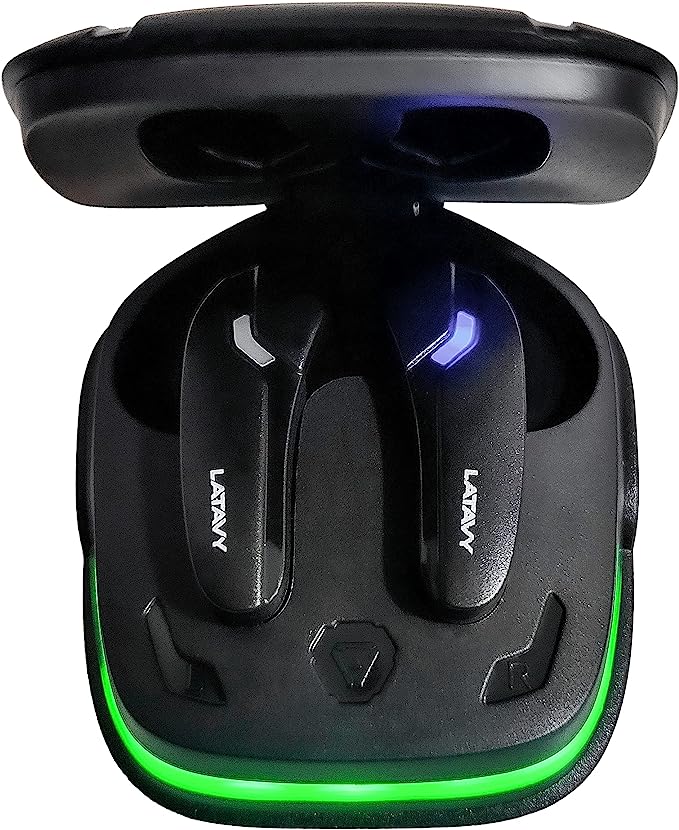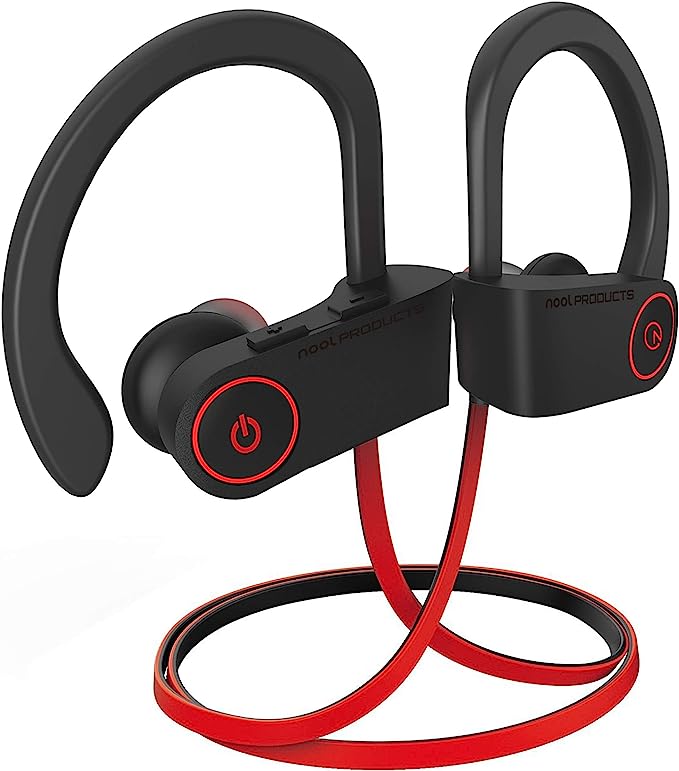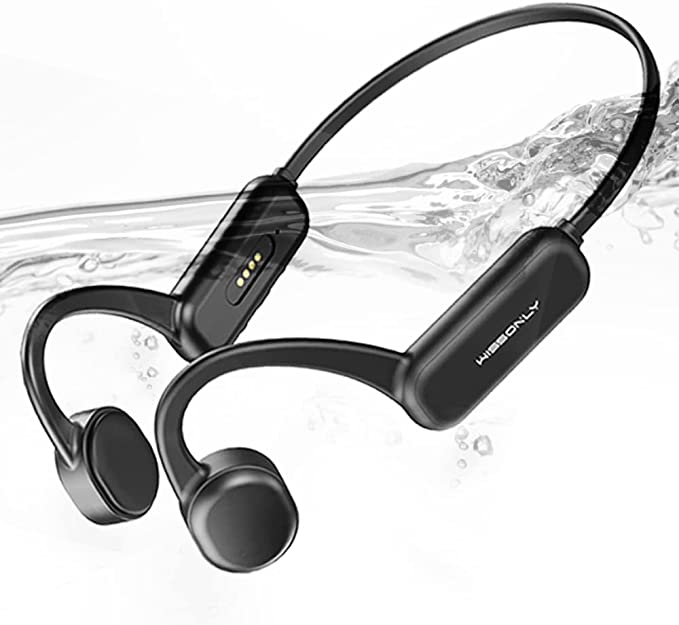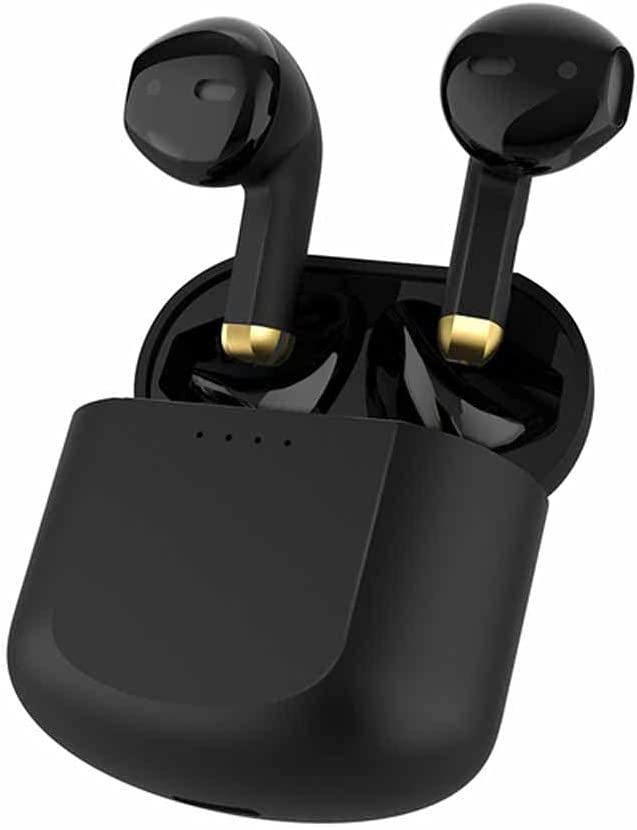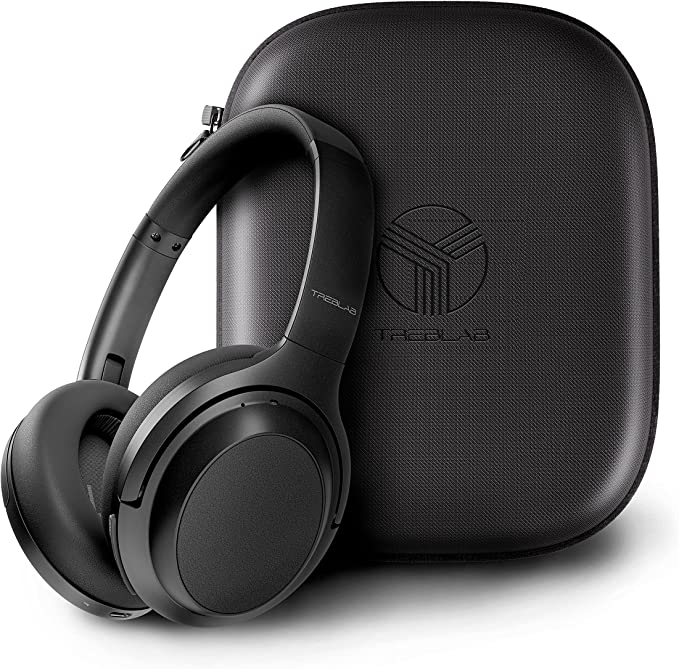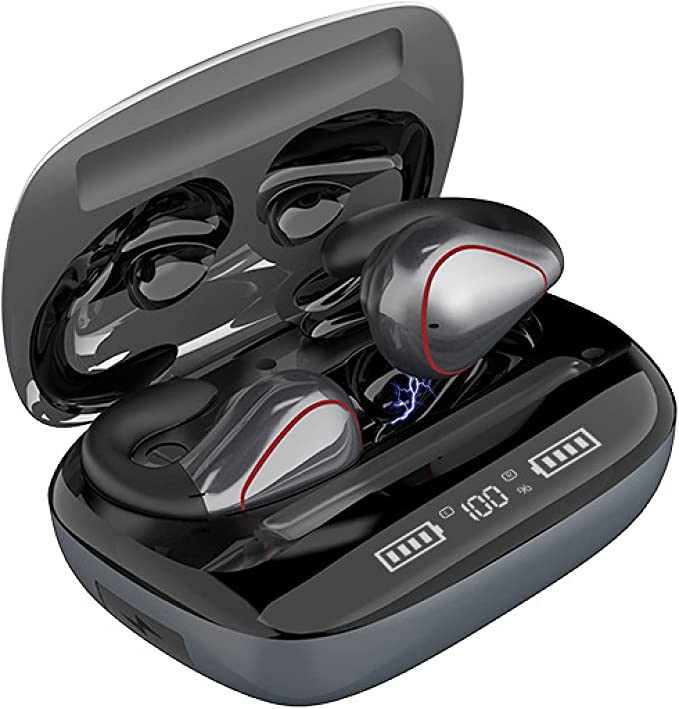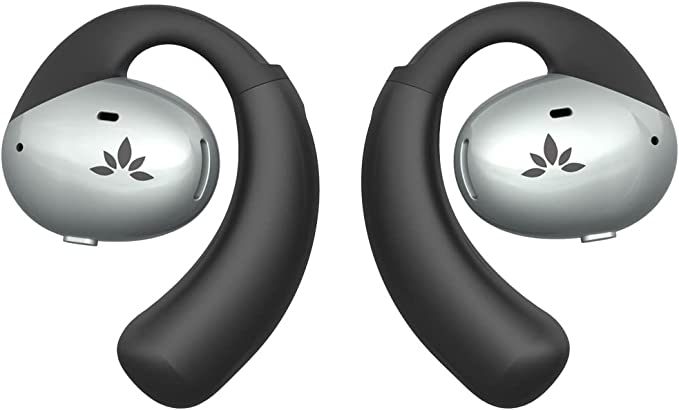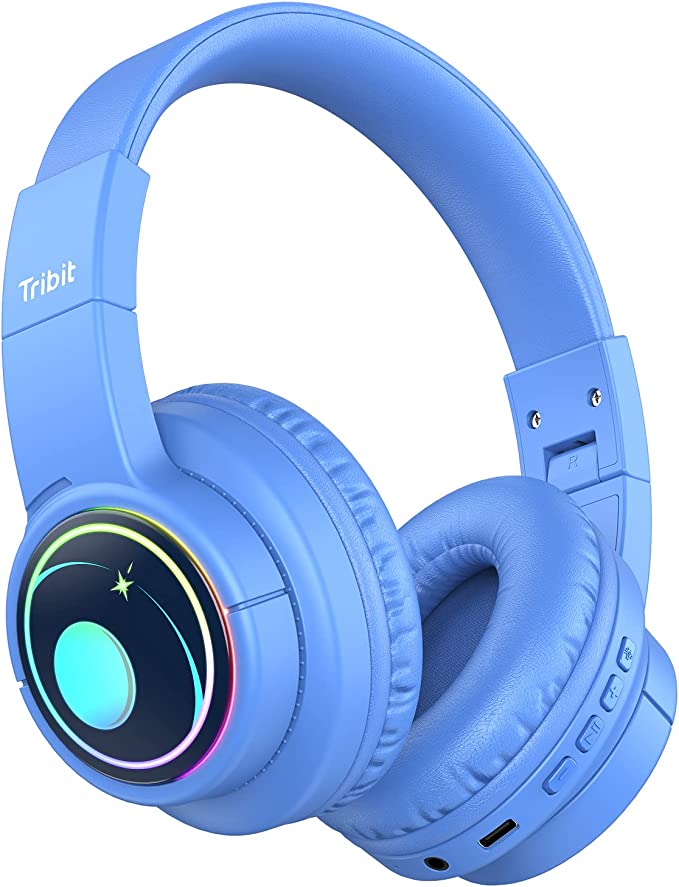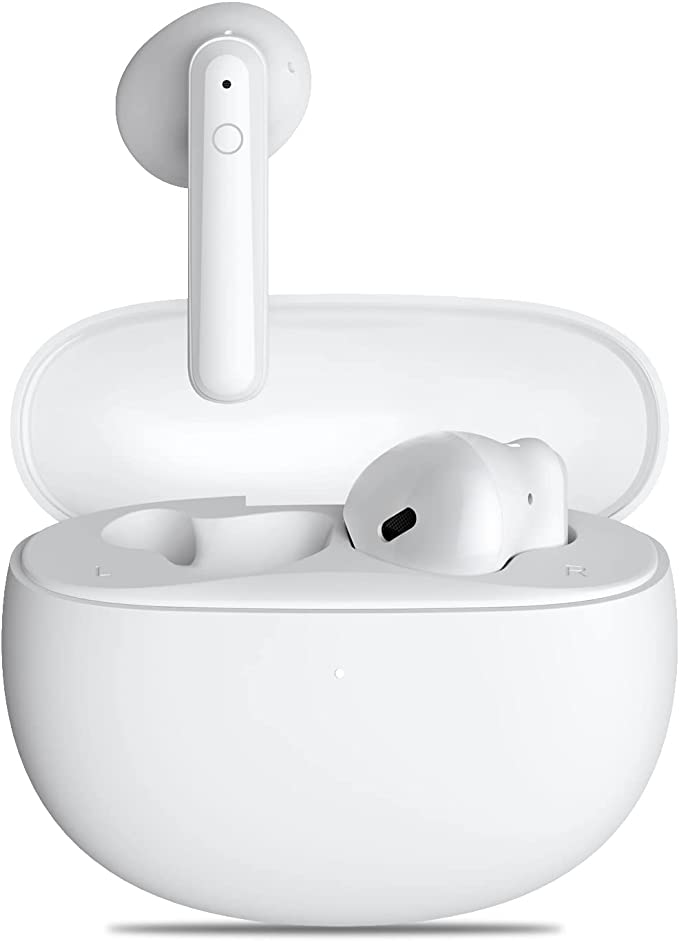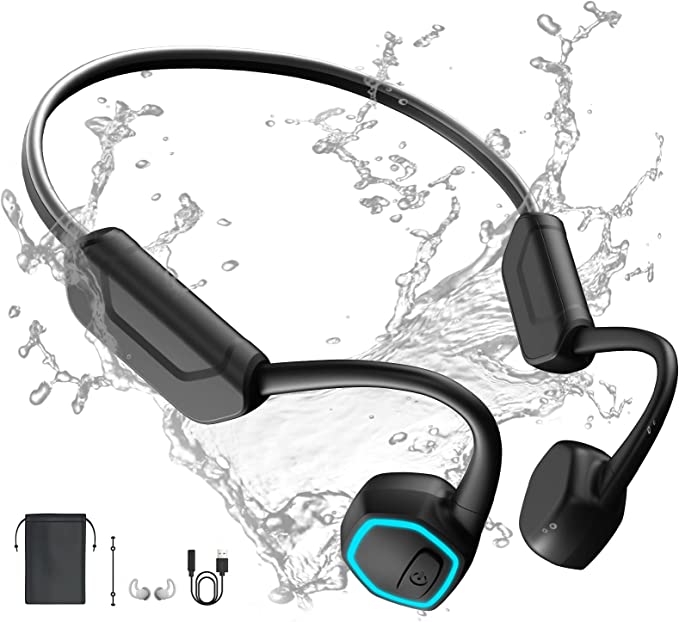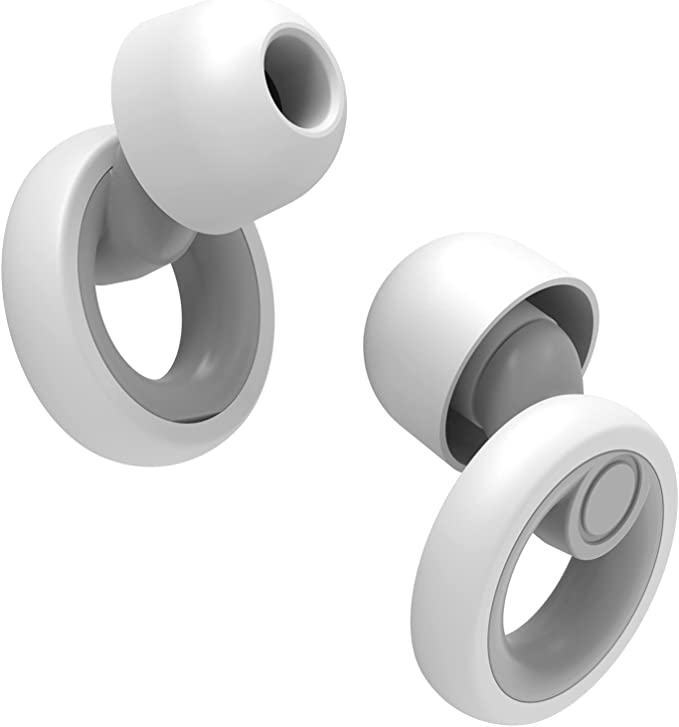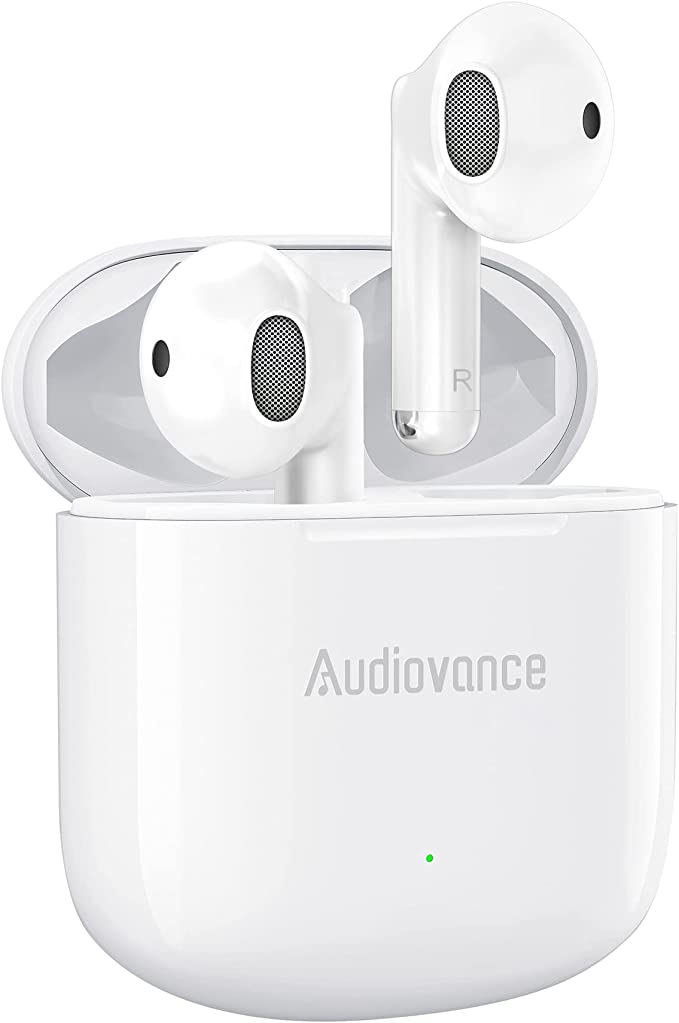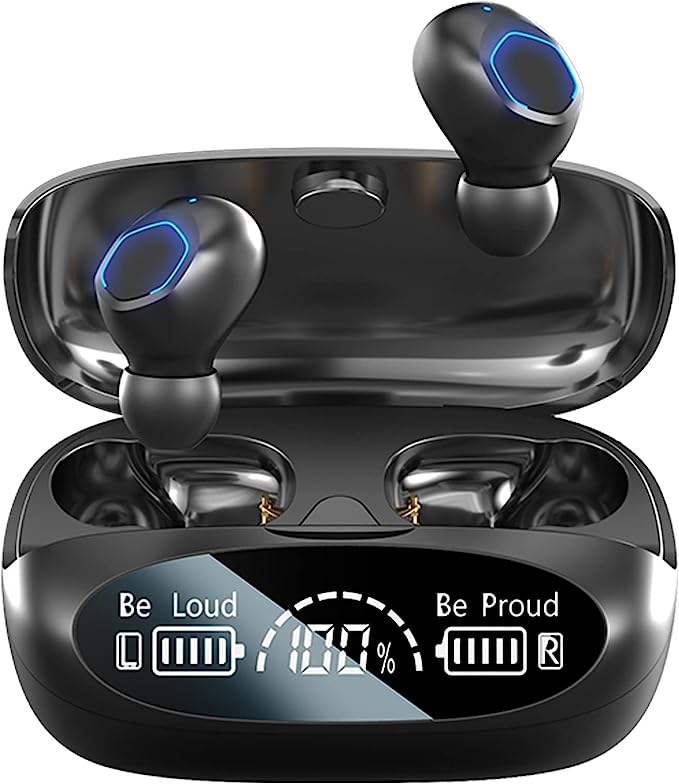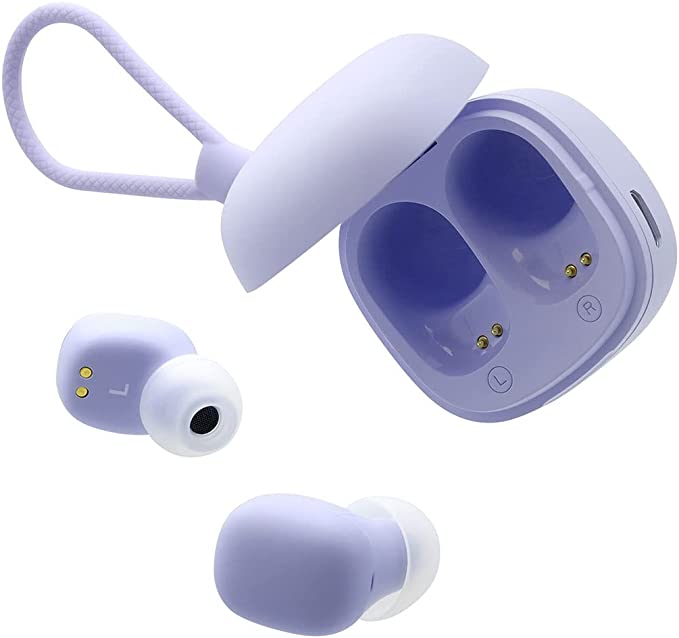WUYI Q61 Wireless Earbuds: Unpacking the Science of Sound, Sport, and Stamina
Update on May 29, 2025, 5:24 p.m.
Ever found yourself untangling a Gordian knot of headphone wires mid-run, the music sputtering just as you hit your stride? Or perhaps you’ve been on an important call, only for your trusty earbuds to gasp their last electronic breath, plunging you into awkward silence? In our wirelessly connected world, the quest for the perfect audio companion – one that’s reliable, sounds fantastic, stays put, and doesn’t require a second mortgage – feels almost universal. Today, we’re not just looking at another pair of earbuds; we’re inviting you to peek under the hood of the WUYI Q61 Wireless Earbuds. Think of them as a fascinating little science lab for your ears, where accessible technology meets everyday needs. Don’t worry, no engineering degree is required for this tour – just a dash of curiosity!

The Marathon Runner: Unpacking 48 Hours of Sonic Freedom
Let’s talk about one of the most pervasive anxieties of modern tech life: battery anxiety. That sinking feeling when your device’s power icon dips into the dreaded red zone. The WUYI Q61s stride confidently into this arena, boasting an impressive 48 hours of total playback time. The earbuds themselves promise around 7 hours of continuous listening from a single charge, with their pocket-friendly charging case acting as a portable power bank, ready to refuel them multiple times. But how does this diminutive duo achieve such sonic stamina? It’s not magic; it’s a clever blend of chemistry and smart engineering.
At the heart of this endurance are Lithium-Polymer (Li-Po) cells. Picture these not as old-school chunky batteries, but as sleek, lightweight “energy bars” for your electronics. Li-Po batteries use a solid or gel-like polymer electrolyte, which allows them to be shaped into compact forms perfect for tiny earbuds, all while packing a higher energy density – more power in less space. This means the Q61s can be light on your ears (a mere 3 grams each, according to the specs!) without skimping on playtime.
But a good battery is only half the equation. The real secret sauce often lies in how that power is managed. Enter Bluetooth 5.3. This isn’t just the latest version number; it’s a significantly more frugal messenger when it comes to energy consumption. Think of older Bluetooth versions as a delivery truck that sometimes idles, burning fuel unnecessarily. Bluetooth 5.3, with its enhanced Low Energy (BLE) protocols, is more like a super-efficient courier on a bicycle, using precisely the energy needed for the task and resting intelligently during pauses. It sips power, rather than gulps it, contributing significantly to those long listening sessions.
And to keep you in the know, the charging case sports an LED digital display. This isn’t just a flashy gimmick; it’s your tiny window into the battery’s soul. Each segment on the display, as WUYI describes, represents about 25% of the case’s remaining charge, and often, these displays also indicate the charge status of the earbuds themselves. Scientifically, this typically involves a tiny microcontroller measuring the voltage of the battery cells. As a battery discharges, its voltage drops, and this reading is then cleverly translated into that user-friendly percentage or bar display. It’s a small touch, but it grants you that satisfying “aha, plenty of juice for the journey!” moment, banishing guesswork. Many users appreciate this clarity, as it directly tackles the “will they last?” question before heading out.

Your Unwavering Workout Partner: The Science of Staying Put & Shaking Off the Elements
For many of us, music is the ultimate workout fuel. But there’s nothing more demotivating than an earbud совершающий музыкальный прыжок (popping out) mid-sprint or during that crucial set. The WUYI Q61s are designed with the active user in mind, featuring flexible, soft silicone earhooks and an impressive IP7 waterproof rating.
Let’s talk about those earhooks. This is where ergonomics, the science of designing for human comfort and efficiency, comes into play. Unlike earbuds that rely solely on friction within your ear canal to stay in place (which can be a bit of a lottery depending on your ear shape), the Q61’s over-ear hook design acts like a gentle anchor. It distributes the earbud’s minimal weight across a larger surface area of your outer ear. This not only enhances comfort by reducing pressure points but, crucially, provides a much more secure fit, especially during vigorous movements. User Mark J, in the provided feedback, specifically noted his appreciation for this “behind the ear earhooks” design, likening it to more expensive models. The choice of silicone is also deliberate. This versatile polymer is soft, flexible, and generally kind to the skin, reducing the chance of irritation during long, sweaty sessions. It’s also quite durable against the oils and sweat your body produces. While one user, Unique1, found the hooks “too flimsy,” this very flexibility is often what allows them to conform to a wider variety of ear shapes, striking a balance between a secure grip and a comfortable feel – though clearly, the perception of that balance can vary.
Now, for the “armor” aspect: the IP7 waterproof rating. “IP” stands for Ingress Protection, and it’s an international standard (IEC 60529, to be precise) that defines how well an electrical enclosure resists intrusion from foreign bodies (like dust) and moisture. The first digit after IP refers to solid particle protection (the Q61 spec doesn’t list this, so we assume it’s unrated or ‘X’ for solids, common when a liquid rating is emphasized). The second digit, ‘7’ in this case, is all about water. An IPX7 rating means the WUYI Q61 earbuds can withstand being submerged in up to 1 meter (about 3.3 feet) of fresh water for up to 30 minutes without damage. Think of it as a protective forcefield. This is typically achieved through meticulous sealing of any seams, hydrophobic (water-repelling) nano-coatings on internal components, and carefully designed watertight barriers for microphone openings and charging contacts. For you, this translates to peace of mind. Sweaty gym sessions? Caught in a sudden downpour on your run? No problem. While it doesn’t mean you should go swimming with them (as sustained pressure or certain chemicals could still pose a risk), for everyday encounters with moisture, the Q61s are built to shrug it off. This resilience is a significant plus for anyone leading an active lifestyle.

“Graphene’s Groove”: The Tiny Sheet Making a Big Sonic Difference
Ultimately, we wear earbuds for the sound. The WUYI Q61 promises “HiFi Stereo Sport Bluetooth 5.3 Headphones with Earhooks, 48H Deep Bass.” A key ingredient in this sonic recipe is its 13.4mm graphene diaphragm. Now, “graphene” sounds like something পরিবর্তন হয়েছে সরাসরি (straight out of) a sci-fi movie, but it’s a real material making waves in the audio world.
So, what is graphene? Imagine taking a pencil lead (which is made of graphite) and shaving off a layer so incredibly thin it’s just a single sheet of carbon atoms arranged in a hexagonal, honeycomb-like lattice. That’s graphene. It’s a Nobel Prize-winning material, celebrated for being astonishingly lightweight yet phenomenally strong – about 200 times stronger than steel by weight! In the world of acoustics, these properties are like striking gold.
The diaphragm in an earbud or headphone is the part that vibrates to create the sound waves your ears perceive. Ideally, you want this diaphragm to be incredibly light so it can respond instantaneously to the electrical audio signal (for crisp, clear high notes and rapid musical changes, often called ‘transients’). You also want it to be extremely stiff, so it vibrates as a perfect piston without deforming or ‘breaking up’, especially when trying to reproduce powerful bass notes or complex musical passages at higher volumes, which can otherwise lead to distortion.
This is where graphene shines. Its remarkable lightness allows it to accelerate and decelerate with incredible speed, faithfully translating the electrical signals into sound waves. Its exceptional stiffness ensures it moves as a single, coherent unit, minimizing unwanted vibrations and distortions. The result? Potentially cleaner, more precise sound across the entire frequency spectrum. This is why some users, like R.K., reported “unbelievable sound…clear and crisp the sound is - bass, treble, beats, harmonies.” The relatively large 13.4mm diameter of the Q61’s driver also plays a role, especially for bass. A larger diaphragm can move more air, and moving more air is fundamental to producing those low-frequency sounds that give music its satisfying “oomph” or “deep bass,” as highlighted in the product description.
However, the world of audio is beautifully subjective. While Mike Hines noted, “The bass is very nice,” he also found it “sometimes too much. Drowns out the highs but not too bad.” David S. even mentioned that for him, “Left and right volume is not equal but if you fiddle with how deep in your ear they are its ok.” These experiences remind us that while material science like graphene aims for objective improvements in driver performance, the final perception of sound is a complex interplay of the earbud’s tuning, the seal it makes in your ear canal (which drastically affects bass perception), the source audio quality, and, of course, your individual hearing and preferences. What’s “perfect bass” to one person might be “too much” for another. The quest for “HiFi” or high-fidelity sound, especially in budget-friendly earbuds, is often about delivering a pleasing and engaging experience rather than adhering to a strict, measurable audiophile standard. For many, the clarity and punch offered by well-implemented graphene drivers at this price point are a significant step up.

The Invisible Handshake: Making Bluetooth 5.3 Your Reliable Ally
A breathtaking audio performance can be instantly shattered by a stuttering, unreliable wireless connection. That invisible handshake between your phone and your earbuds is crucial. The WUYI Q61 comes equipped with Bluetooth 5.3, which, at the time of its release and incorporation, was a very current iteration of this ubiquitous wireless standard.
But what does “5.3” actually mean for you, the listener? It’s not just an incrementally larger number; it brings tangible improvements:
- Enhanced Power Efficiency: We touched on this earlier. Bluetooth 5.3 refines the Bluetooth Low Energy (BLE) protocols, allowing devices to communicate effectively while sipping minimal power. This is a cornerstone of the Q61’s impressive battery life.
- Improved Connection Stability: Life is full of wireless signals – Wi-Fi routers, microwaves, other Bluetooth devices. Bluetooth 5.3 includes features like “Channel Classification” where the connection can intelligently identify and avoid “noisy” channels, reducing interference and leading to a more robust, dropout-resistant link. This is particularly welcome in crowded urban environments or busy gyms.
- Potentially Lower Latency: Latency is that tiny, sometimes annoying delay between what you see on a screen and what you hear in your earbuds. While the specific audio codecs (the compression methods used to send audio over Bluetooth) supported by the Q61 aren’t detailed in the provided info, Bluetooth 5.3’s improved data handling capabilities can support more efficient codecs or faster transmission, which generally helps in reducing this lag. This makes watching videos or playing games a more synchronized and enjoyable experience.
- Effortless “Auto-Pairing”: The convenience of earbuds that “just connect” after the initial setup is a modern marvel. This “auto-pairing” feature typically involves the earbuds storing your phone’s (or other source device’s) unique Bluetooth MAC address in their memory. When powered on, they quickly look for and reconnect to that familiar device, like greeting an old friend.
Despite these technological strides, the laws of physics still apply. Wireless signals, especially the relatively low-power ones used by Bluetooth, can be affected by obstacles. User Lloyd reported a fascinating (and repeatable) observation: “when I raise my arm up next my head and next to an earpiece, it will interfere with the bluetooth connection to my phone.” This phenomenon, often called “body blocking,” is quite common. Our bodies are largely made of water, which is excellent at absorbing radio frequency signals in the 2.4 GHz band that Bluetooth uses. An arm, or even just a hand, placed directly between your phone (especially if it’s in a pocket on the opposite side of your body from the primary earbud antenna) and the earbud can attenuate, or weaken, the signal enough to cause a brief interruption. The specific antenna placement within both the earbuds and the phone, as well as other nearby sources of RF interference, can also play a role. It’s a reminder that even our most advanced wireless tech still has to navigate the complexities of the real, physical world!

Whispers & Shouts: The Art of Being Heard and Finding Your Focus
In today’s world, our earbuds often serve a triple duty: delivering our favorite tunes, facilitating clear conversations, and sometimes, offering a precious bubble of focus amidst a noisy environment. The WUYI Q61 product page mentions “Noise Cancelling” and a “Built-in Microphone” for “crystal clear calls.” Let’s unpack these.
The term “Noise Cancelling” can be a bit of a catch-all. Given the Q61’s price point and the available user feedback, it’s highly probable that the primary mechanism at play here is passive noise isolation. Think of it as the “earplug effect.” The in-ear design of the earbuds, coupled with the seal created by the soft silicone ear tips, physically blocks a certain amount of external sound from reaching your eardrums. This is quite effective against high-frequency sounds, like chatter or the clatter of keyboards. It’s different from, and generally less potent than, Active Noise Cancellation (ANC), which is a more complex technology. ANC uses tiny microphones to listen to ambient noise and then generates opposing sound waves (anti-noise) to actively cancel it out, particularly effective for low-frequency rumbles like engine noise or air conditioning hum. User Lucy Mckinney’s comment, wishing the earbuds “had more hours there’s only last about 4 hours when I wish it would last between 6:00 and 8:00 hours” (which seems to conflate battery life with a wish for better noise cancelling, but the sentiment about wanting more from the noise cancelling feature is clear), further suggests that a sophisticated ANC system is likely not what’s on offer here. However, good passive isolation can still significantly reduce distractions, allowing you to immerse yourself more fully in your audio.
When it’s time to switch from listening to talking, the built-in microphone (or microphones, as many modern earbuds use more than one) takes center stage. The goal is “crystal clear calls.” These microphones are typically tiny marvels of engineering called MEMS (Micro-Electro-Mechanical Systems) microphones. Their effectiveness for calls depends on several factors: their quality, their placement within the earbud (to best pick up your voice while minimizing noise pickup), and any noise reduction algorithms that might be employed by the earbud’s chipset. While the provided information doesn’t detail specific call-related noise reduction tech (like cVc – Clear Voice Capture), it’s common for even budget-friendly earbuds to have some basic processing to help distinguish your voice from steady background hum. The observation from David S. that the earbuds “(my pair) works better for phone calls with both in my ears” is interesting. This could imply that the system might use inputs from microphones in both earbuds simultaneously for better voice isolation (a common technique in more advanced systems), or it could simply be that having both earbuds in creates a more stable and well-sealed acoustic environment, improving how your voice is captured and how you hear the other person. Clear communication is key, and it’s an area where even small technological choices can make a noticeable difference.

A Tap, A Swipe, A Symphony: The Nuance of Touch Controls
The sleek, button-free aesthetic of modern earbuds often relies on touch-sensitive controls. The WUYI Q61 is no exception, featuring “sensitive touch controls” that allow you to manage music playback (play/pause, volume, track switching), handle calls, and even activate your phone’s voice assistant with a series of taps or presses.
How does this fingertip magic work? Most commonly, it’s through capacitive touch sensing. Your body, being a pretty good conductor of electricity, has a natural electrical capacitance. The surface of the earbud designated for touch control has a sensor array embedded beneath it. When your fingertip, with its inherent capacitance, comes into contact with or very close to this sensor, it changes the local electrical field or capacitance at that point. A tiny microcontroller within the earbud detects this change and interprets it as a specific command based on the location, duration, or number of taps. It’s the same fundamental technology that powers most smartphone touchscreens.
The beauty of touch controls lies in their seamless integration into the earbud’s design – no moving parts to wear out, and a cleaner look. However, the term “sensitive” can indeed be a double-edged sword. As Louise Munday, a user from the UK, aptly put it: “the touch is quite sensitive. When running and sweaty, if my hair falls onto one of the earpieces it can switch the song or turn that head phone off - which can be a little annoying.” This highlights a common engineering challenge: calibrating the sensitivity of these sensors. They need to be responsive enough to register deliberate touches reliably, yet not so delicate that they trigger false positives from an errant strand of hair, a bead of sweat, or an accidental brush. Some users also mentioned initial difficulty in mastering the commands (“I had to practice to figure out commands,” said R.K.), which is common with gesture-based interfaces. Another user, Unique1, reported an issue where “the volume is always on max, even though I have adjusted it…it always goes back to the max setting.” This could be a firmware quirk related to how the touch commands for volume are registered or remembered, or perhaps an interaction with the source device’s volume settings. Finding that perfect balance in touch control design is an ongoing art in the world of wearable tech, aiming for intuitive power without unintended consequences.

The Sum of Its Parts: More Than Just Wires and Woofers
Looking at the WUYI Q61, it’s easy to see a collection of individual features: long battery life, sporty earhooks, graphene drivers, Bluetooth 5.3, IP7 waterproofing, and touch controls. But the true experience of any piece of technology isn’t just in its spec sheet; it’s in how these components work together to serve a purpose. In this case, the purpose is to deliver a convenient, resilient, and enjoyable audio experience, particularly for those with active lifestyles or a desire for hassle-free daily listening.
The WUYI Q61 appears to be a thoughtful exercise in what’s often called the “value equation” in consumer electronics. It’s not necessarily about packing in every single cutting-edge, top-of-the-line component, which would inevitably drive up the price. Instead, it seems to focus on leveraging mature, reliable technologies (like well-implemented Bluetooth and Li-Po batteries) and strategically incorporating newer, impactful ones (like graphene diaphragms) where they can offer a discernible benefit without making the product prohibitively expensive. The earhook design directly addresses a common pain point for active users (earbud stability). The IP7 rating provides practical, real-world durability. The extended battery life liberates users from constant charging.
It’s this combination, this balancing act, that often defines a product’s success in a competitive market. It’s an invitation for us, as users, to become more curious listeners – not just to the music or podcasts, but to the subtle ways technology enhances our daily routines. These little gadgets in our ears are small marvels of engineering, and understanding a bit about what makes them tick can make us appreciate them all the more.

Coda: The Enduring Note of Innovation
So, what’s the final note on the WUYI Q61 Wireless Earbuds, viewed through a scientific lens? They present a compelling “scientific personality”: a blend of chemical power storage, material science ingenuity for sound, radio wave wizardry for connectivity, ergonomic design for comfort and stability, and a dash of fluid dynamics defense against the elements. They are a testament to how far accessible audio technology has come.
Ultimately, understanding the “why” behind the “what” – the science underpinning the features – empowers us. It allows us to move beyond marketing buzzwords and make more informed choices about the technology we invite into our lives. The WUYI Q61, like many contemporary gadgets, serves as a reminder that innovation isn’t just happening in high-end flagships; it’s also cleverly at work in making sophisticated experiences more attainable for everyone. And as personal audio technology continues its rapid evolution, one thing is certain: the symphony of science in our ears is only going to get more interesting.
